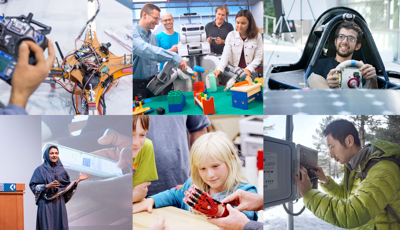Ming Wu has been appointed the new Chief Scientist for
CITRIS at Berkeley. He is currently Professor of Electrical Engineering and
Computer Sciences at Berkeley, and Co-Director of Berkeley Sensors and
Actuators Center (BSAC).
News
Newsletter: Smart HCCI Cars, and Predicting Direct Solar Irradiance
The June 2008 newsletter is now online, with two stories on key energy projects in both engine development and predicting solar availability for utilities.
Energy Shock: Perspective by Dan Kammen
A perspective by Professor Daniel Kammen on the energy crisis and the role of the C-GRACE meeting with CITRIS and the Copenhagen Climate Council.
Cell Phone as a Platform for Healthcare Awards from MSR
CITRIS projects at Berkeley and Santa Cruz using cell phones as a
healthcare platform are among the projects supported by a recent Microsoft Research initiative.
UC Santa Cruz to lead pioneering study of pumas in the Santa Cruz Mountains
Led by an interdisciplinary team of researchers at the University of California,
Santa Cruz, and using innovative collars made at CITRIS, the project will shed light on the movement, range, physiology, and
predatory habits of pumas.
GPS, Cell Phones, and Rush Hour featured on ABC News
A research project between UC Berkeley and Nokia tests how well cell phone GPS can gauge
upcoming traffic and is featured online here.
Winners announced for Big Ideas contest
Six projects were awarded a total of $30K at this year's CITRIS Big Ideas contest, with the top two prizes going to healthcare-related issues.
Low-cost fuel cell project wins CET competition
A group that wants to make a cheap fuel cell that can efficiently convert hydrocarbon fuel into
electricity won this year's CET Cleantech Innovation Contest.
UCSC computer scientists develop solutions for long-term storage of digital data
Ethan Miller's group has come up with a new approach, called Pergamum, which uses hard
disk drives to provide energy-efficient, cost-effective storage.
Newsletter online: CellScope, and Eye care in India
The April newsletter features stories about technology for social impact: CellScope (cell phone + microscope) and enabling eye care in India using cheap, reliable Wi-Fi.
Green Technology Entrepreneurship Academy, July 7 – 11, 2008
The Green Technology Entrepreneurship Academy (GTEA)
provides science and engineering research faculty, post-docs and doctoral
students with the necessary knowledge and skills to move environmentally
sustainable and green technology research out of the laboratory and into
practice.
Graduate Student’s work featured in MoMA Exhibit
Matthew Scullin, Graduate Student in the Department of Materials Science and Engineering at UC Berkeley, is part of a collaborative exhibit currently on display at the Museum of Modern Art in New York City.
Intel and Microsoft launch Par Lab at UC Berkeley
UC Berkeley is partnering with Intel and
Microsoft to accelerate developments in parallel computing and advance the
powerful benefits of multi-core processing to mainstream consumer and business
computers.
Banks, phone companies are identity-theft targets
A recent study by CITRIS researchers shows that banks and telecommunications companies are top targets for identity-theft.
Carbon calculator debuts
The latest edition of the CoolClimate Calculator shows people as well as cities and businesses how their lifestyles contribute to
global warming and identifies areas where they can reduce their footprint.
Video from Chris Somerville’s talk is available
The video from Chris Somerville's talk on "Development of Cellulosic Biofuels" is now available online.
Digital education and air monitoring projects win awards
An online mystery game in which student sleuths will monitor air pollution in
South Central Los Angeles and in Cairo, Egypt, and a project using cell phones
to teach English to children in India have won funding for two UC Berkeley professors
Demand Response Research Featured on Local TV News
UC Berkeley PhD student Dan Steingart and his research on printable batteries was recently featured on a television news story by Bay Area ABC7 News.
View news story
Next-generation nuclear power and Monitoring air quality
Read about innovative work at CITRIS in the latest newsletter, now on-line.
California Seeks Thermostat Control
A recent NY Times articles discusses the challenge and possible solutions to California's concerns about available energy, including the Demand Response project at CITRIS.
Joint Nokia research project to capture traffic data
Researchers from the University of California, Berkeley, and Nokia recently tested technology that could
soon transform the way drivers navigate through congested highways and
obtain information about road conditions.
CITRIS welcomes Heidi Hallett to staff
CITRIS is pleased to welcome Heidi Hallett as our new colleague and leader of the business aspects of CITRIS on all four campuses.
Carbon calculator honored in California magazine
To assist consumers, researchers at Berkeley
Institute of the Environment are
developing an online carbon-tracking calculator that produces a summary of all the greenhouse
gases produced by specific consumer goods.
Craigslist to establish first endowed faculty chair in new media
UC Berkeley has announced
plans to establish the first endowed faculty chair at the Berkeley Center for
New Media with a donation of $1.6 million from craigslist, one of the most
popular Web sites in the world.
